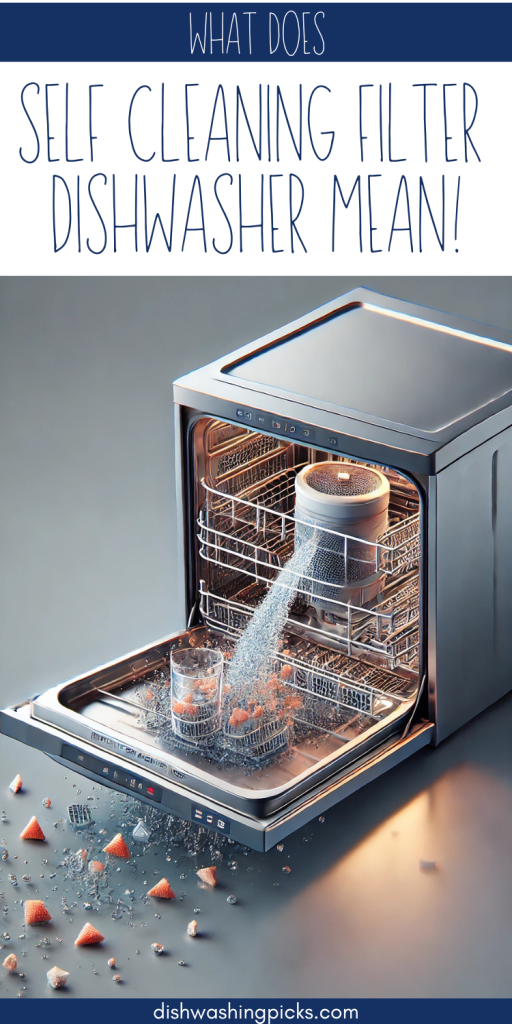
Alright, let’s talk dishwashers—specifically, those fancy ones that claim to have a self-cleaning filter. Sounds pretty convenient, right? No more scooping out soggy food bits or scrubbing gunk from the bottom? Well, kind of. Let’s break it down.
The Mystery of the Self-Cleaning Filter
Imagine you’ve just finished a big, greasy meal. You scrape off the leftovers (because we’re not monsters), toss the dishes in the dishwasher, and press start. Now, here’s the question: where does all that food debris go?
In some dishwashers, especially older models, there’s a manual filter—a mesh screen at the bottom that catches food particles. If you don’t clean it regularly, it turns into a horror show of soggy leftovers. But in a self-cleaning filter dishwasher, things work a little differently.
Instead of trapping food in a filter that you have to clean, these models use a grinding mechanism (kind of like a tiny garbage disposal) to break down food waste into tiny particles. Those particles then get flushed away with the wastewater, meaning you don’t have to remove any filter or deal with any smelly gunk buildup. Pretty neat, right?
But Does It Really Clean Itself?
Here’s where things get interesting. While self-cleaning filters do a great job of breaking down food, they’re not magic. If you’re dealing with extra greasy or starchy foods (looking at you, pasta night), some residue might still build up over time. That’s why occasional maintenance—like running a dishwasher cleaner or a vinegar rinse—can still be a good idea.
So, what’s the bottom line? Self-cleaning filter dishwashers do reduce the need for filter maintenance, but they’re not 100% set-it-and-forget-it. Want to know how they compare to manual filters and which type might be better for you? Let’s dive into that next.
Self-Cleaning Filter vs. Manual Filter: Which One’s Better?
Alright, so now that we know what a self-cleaning filter is, let’s tackle the big question: Is it actually better than a manual filter? Well, that depends on what you consider “better.” Let’s break it down.
1. Convenience: Do You Want to Clean the Filter Yourself?
If the thought of scraping soggy food bits out of a dishwasher filter grosses you out, the self-cleaning option might be your best friend. Since it pulverizes food waste into tiny particles and flushes them away, you don’t have to remove and wash a filter regularly.
On the flip side, manual filter dishwashers trap food in a mesh screen that needs to be cleaned every so often (usually once a week or more, depending on how much you use your dishwasher). If you ignore it? Well… let’s just say your kitchen might start smelling questionable.
Winner: Self-cleaning filter—because who actually wants to scrape out old food?
2. Noise Level: How Quiet Do You Like Your Dishwasher?
Self-cleaning filters use a grinding mechanism (kind of like a mini garbage disposal), which means they can be noisier than their manual counterparts. If you love a peaceful home and don’t want to hear your dishwasher rumbling in the background, manual filters tend to be much quieter since they don’t have a built-in grinder.
Winner: Manual filter—if you value a quieter kitchen.
3. Cleaning Performance: Which One Washes Dishes Better?
Here’s the thing: both types of filters can get your dishes sparkling clean—as long as you’re using your dishwasher correctly (yes, there’s a right way). However, because self-cleaning filters rely on flushing food particles away, they can sometimes struggle with heavier, stickier food residue, like melted cheese or thick sauces. Manual filter dishwashers, on the other hand, tend to have better filtration, meaning fewer food particles get redeposited onto your dishes.
Winner: Manual filter—for better overall filtration.
4. Maintenance: Which One Requires Less Work?
You might assume a “self-cleaning” filter means zero maintenance, but that’s not entirely true. Over time, grease and residue can build up in self-cleaning systems, meaning you’ll still need to run a dishwasher cleaner or vinegar rinse occasionally to keep things fresh.
Manual filters? Well, they require regular hands-on cleaning, which can be annoying but also ensures you’re staying on top of maintenance.
Winner: Self-cleaning filter—less frequent maintenance, even if it’s not totally hands-free.
So, Which One Should You Choose?
It comes down to your priorities:
- Hate cleaning filters? Go for a self-cleaning filter.
- Want the quietest dishwasher possible? A manual filter is the better choice.
- Care most about cleaning performance? Manual filters have an edge.
- Prefer less maintenance overall? Self-cleaning wins.
At the end of the day, both options have their pros and cons. But whichever one you choose, the real key to a cleaner dishwasher (and cleaner dishes) is using it properly. Want to know some tips to boost your dishwasher’s cleaning power—no matter which filter type you have? Let’s dive into that next!
How to Boost Your Dishwasher’s Cleaning Power (No Matter the Filter Type)
Alright, whether you have a self-cleaning filter or a manual filter, one thing’s for sure—you want your dishwasher to do its job well. Because let’s be honest, there’s nothing more annoying than pulling out a “clean” plate and finding mystery crumbs still stuck to it. So, how can you make sure your dishwasher runs at peak performance? Let’s go over some easy, effective tips.
1. Load It Like a Pro
Yes, there is a right way to load a dishwasher. And no, cramming in every last dish like a game of Tetris isn’t it.
Here’s what you should keep in mind:
- Plates – Face them toward the center so water sprays evenly.
- Bowls & Cups – Angle them downward to avoid water pooling.
- Pots & Pans – Keep them on the bottom rack for max water pressure.
- Utensils – Mix them up (spoons shouldn’t nest together, or they won’t get clean).
🚫 What NOT to do: Overlapping dishes, blocking the sprayer arms, or shoving everything in like you’re packing a suitcase. Let the water do its thing!
2. Use the Right Detergent (and the Right Amount)
Not all dishwasher detergents are created equal. If you’re using the cheapest one you can find, you might not be getting the best results. Look for a high-quality detergent—whether it’s pods, powder, or liquid—to break down grease and stuck-on food.
But here’s the trick: More detergent ≠ cleaner dishes. In fact, using too much can leave a filmy residue. Stick to the recommended amount, and if you have hard water, consider adding a rinse aid to prevent spots.
3. Keep the Spray Arms and Filter Clean
Even if you have a self-cleaning filter, occasional maintenance helps. Check the spray arms for food blockages—if they’re clogged, water won’t reach your dishes properly. And if you have a manual filter, clean it once a week to avoid buildup.
🛠 How to Clean Your Dishwasher (Quick & Easy):
- Remove and rinse the filter (if manual).
- Wipe down the door seal and interior with a damp cloth.
- Run a cycle with vinegar (top rack in a bowl) to break down grease.
- Sprinkle baking soda on the bottom and run a short cycle for freshness.
Do this once a month, and your dishwasher will thank you.
4. Use Hot Water for Best Results
Did you know most dishwashers work best at 120–140°F? If your water isn’t hot enough, grease and food residue won’t break down properly. Run the kitchen sink faucet with hot water for a few seconds before starting your dishwasher to ensure it fills with hot water right away.
5. Don’t Overlook Cycle Settings
Most people just press “Normal” and walk away, but different settings exist for a reason!
- Heavy / Pots & Pans – Best for greasy, baked-on food.
- Quick / Express – Saves time but might not clean as thoroughly.
- Sanitize – Uses extra heat to kill bacteria (great for baby bottles).
- Eco Mode – Saves water and energy but takes longer.
If your dishes aren’t coming out clean, experimenting with different settings can make a huge difference.
Final Thoughts
No matter which filter type your dishwasher has, proper loading, regular maintenance, and the right detergent can dramatically improve its cleaning power. And if you’ve been skipping these steps, don’t worry—you’re not alone. Just try a few of these tips, and you’ll notice the difference in no time.
